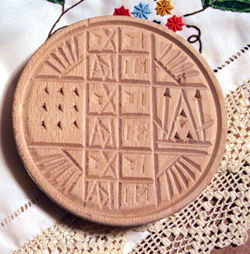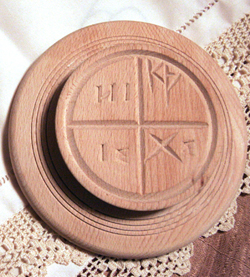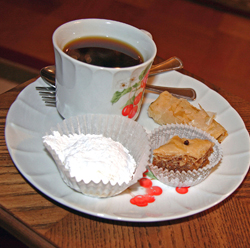Other Shreveport Articles
Cultural Preservation: Keeping the Flame Burning for Future Generations
Seasons and Cycles — Festivals and Rituals Mark Life's Rhythms
Of Hand and Heart: Handwork Connects Family and Community

Shreveport's Greek Community: Cultural Treasure Spanning Generations and an Ocean
By Laura Marcus Green
Spiritual Sustenance: Greek Orthodox Ritual Foods
As St. George congregation members, Magda and Dena also take part in the rotation of women who bake bread for communion for Sunday morning services. Communion bread is among several ritual foods that play an important part in Greek Orthodox worship. The ingredients and manner of preparing these foods have symbolic value, connecting them to particular beliefs or rites.

The communion bread is made from simple ingredients: flour, water, yeast and salt. Its preparation for communion by the bakers and then by the priest is prescribed by Orthodox tradition. Before the round communion loaf goes into the oven, the baker embosses its top using a wooden stamp. The stamp is carved with designs that signify the Virgin Mary, Jesus Christ, the Apostles, the Prophets, and angels. Most lines in the stamp have significance. The baker brings the loaf to the church a day or two before the service for which it is needed. The lines in the design show the priest where to cut the bread for communion. Before cutting the bread, the priest prays over it to bless it, for the living and the dead. He then puts the bread in a large chalice from which congregants take a piece during communion. Any remaining bread is served during the coffee hour following the service.
Both Magda and Dena grew up with this tradition in Greece from the time they were little. Magda's bread stamp was among the things she brought from home when she moved to Shreveport. Whereas Magda had time to internalize the process before immigrating to the United States, Dena says she was "still practicing" when she left her home country and her mother's kitchen. When her turn came to bake communion bread at St. George, some of the older women took her under their wing and helped her master the technique. Dena points out that the dough must be very stiff, in order to maintain the stamped design during baking. This once meant that she kneaded the dough at length. Today, she achieves stiff dough with the help of an electric mixer equipped with a bread hook. Women from different cultures in St. George's diverse congregation take part in baking the communion bread. Magda and Dena feel that baking the bread fulfills an important role in Orthodox practice. Dena says, "It is an honor, I think, because you make it for your church, for the Holy Communion."

Communion bread is one of several hand-prepared foods that have prominence in Orthodox ritual. In addition to her place in the communion bread rotation, Magda Panos is also called upon to prepare other traditional foods for her church. When she left her home country as a new bride she brought recipes that are required for ritual occasions. A boiled wheat dish called kóllyva is prepared for memorial services that take place at certain intervals after a person has died. At St. George Greek Orthodox Church, these services are held on anniversary dates beginning with three days after death, then forty days, and every year on the anniversary. Magda says that in Greece, the services are held at three days, nine days, forty days, three months, six months, nine months, and a year. She explains that multiples of three relate to the Trinity.
Father Brendan of St. George Greek Orthodox Church describes the memorial service. A small table bearing the kóllyva is situated in the middle of the church, in front of the congregation. A set of prayers is chanted and special hymns are sung, including "May Their Memory Be Eternal." These memorial songs are not printed in any hymnal; people know them by heart. The service helps people remember their loved one, so that his or her life does not disappear from memory. Kóllyva is prepared from boiled wheat, which is then mixed with sugar, pecans, walnuts, raisins, parsley or cilantro, and sometimes a red ingredient like pomegranate. Father Brendan has noticed that the ingredients vary depending on people's country or region of origin or family traditions. Explaining kóllyva's significance he says,
It represents the sweetness and the bitterness of life. There are almonds in it that are the bitterness. And its sweetness at the time of death, symbolizing resurrection. So with that special dish, they have a set of prayers that are said. And then, the men take the dish downstairs and it's given to all the people in little cups. And they all eat from that.
Preparation of kóllyva is a specialized process that must be done just so, or the wheat will spoil. Not everyone knows how to make it. Magda says that the original recipe in Greece was just the boiled wheat and sugar, and that people began adding to it. Some ingredients are included purely for flavor, like sesame seeds or cinnamon. Others symbolize certain aspects of the memorial service. Dena Kosmitis has heard that green means the deceased is relaxing in green pastures. Red signifies Jesus' blood. She remembers that during her childhood, wheat was the only ingredient. She wonders whether this was because people could not afford the other ingredients during the depression and wartime era in which she was raised. The variations in kóllyva illustrate how cultural traditions change as they move through time and space.

Regardless of the recipe, the process remains the same. The wheat is boiled, cooled, mixed with the desired ingredients, and then placed on a tray. The wheat is then covered with powdered sugar to make it look nice. From there, the kóllyva is decorated with a cross in the center, the person's initials, sometimes the person's dates, and the letters AHEPA, if the person was a member. The cross, letters, and numbers are all in silver.
Another specialty of Magda's is the bread for the Artoklásia service, which translates "breaking bread." Magda also calls the service and the bread "five loaves." Artoklásia acknowledges God's blessings and commemorates the miracle of Christ's multiplying five loaves of bread to feed 5,000 people. Magda bakes five loaves for the Artoklásia service from a dough sweetened with sugar. She explains that congregants may request an Artoklásia at any time from the priest, who conducts the special service after the liturgy. An Artoklásia service might be held for a variety of reasons, including offering good health to someone who is sick or marking a special day in the Orthodox or Greek calendar, such as August 15th (the Dormition of Mary), March 25th (Greek Independence Day), the health of an organization like Philoptochos, Founders Day, or others. Following the service the five loaves are cut up and shared among those present. Through her specialized knowledge, Magda provides a valuable service to her community.


